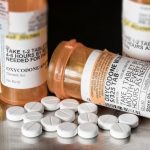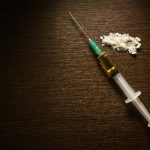- Dangers Of Vicodin Abuse
- Signs Of Vicodin Addiction
- Vicodin Withdrawal
- Treatment For Vicodin Addiction
- FAQs
Vicodin is the brand name of a synthetic opioid pain reliever made with hydrocodone and acetaminophen. Like other opioids, it’s highly addictive and can cause physical dependence.
Dangers Of Vicodin Abuse
Vicodin is a prescription painkiller for moderate to severe pain. It can be helpful when taken as prescribed. But in most cases, opioids should not be used for long-term pain relief.
You’re abusing Vicodin if you take it for longer than prescribed, at a higher dose than recommended, or without a prescription. Crushing the pills to snort, smoke, or inject is also Vicodin abuse.
Vicodin abuse can lead to unwanted side effects, overdose, addiction, and dependence. If you obtain the drug illegally, you may end up with something that isn’t Vicodin (hydrocodone) at all.
Vicodin Side Effects
When you abuse Vicodin, you raise the risk of having side effects, some of which may be severe.
Vicodin side effects include:
- drowsiness
- dizziness
- lightheadedness
- nausea
- vomiting
- constipation
- dry mouth and throat
- rash or itchy skin
- pinpoint pupils
- mood swings
Some serious side effects of Vicodin are:
- sweating or shivering
- slow or unsteady breathing
- racing heart rate
- loss of appetite
- weakness
- tightness in the chest
- muscle stiffness or twitching
- decreased coordination
- agitation or confusion
- hallucinations (seeing or hearing things that aren’t real)
Vicodin Overdose
Abusing Vicodin increases the chance of overdose. Taking a high dose of opioids can slow down your central nervous system too much. You might stop breathing, go into a coma, or die. If you survive, you may experience brain damage from a lack of oxygen during the overdose.
Mixing Vicodin with other depressant drugs—such as alcohol, benzodiazepines, or other opioids—increases the risk of severe respiratory depression and death.
Vicodin overdose can also cause liver damage, as too much acetaminophen is harmful to the liver.
Illicit Vicodin
With prescription drug monitoring programs and more awareness about the addictiveness of opioids, it’s not always easy to get a Vicodin prescription. Buying it on the street may be an attractive alternative.
But what you get on the street is often homemade and cut with substances like talcum powder and lidocaine (an anesthetic). Illicit Vicodin might be laced with fentanyl, a powerful opioid drug linked to a startling rise in drug overdose deaths in recent years.
Vicodin Addiction & Dependence
Even if you take Vicodin (hydrocodone) as prescribed, your body builds a tolerance to it over time, needing more of the drug for the same effect.
Your body may also start to rely on Vicodin and its natural pain-relieving ability will decrease. When you stop taking the drug, your body will react adversely if you’ve developed a physical dependence.
Vicodin use can also change the way your brain is structured. When you are addicted, you crave the drug above all else, despite noticeable damage to your life and health.
Signs Of Vicodin Addiction
Someone with a Vicodin addiction may try to hide it but this is a challenge as the addiction progresses. It may even be the person’s secretive behavior that alerts their friends or family members to the problem.
Signs of Vicodin addiction include:
- needing Vicodin to get through the day, not just for pain relief
- getting multiple Vicodin prescriptions from different doctors (doctor shopping)
- obtaining Vicodin without a prescription (unmarked pill bottles or little bags of pills)
- borrowing or stealing money to pay for drugs
- money problems (not being able to pay for basic needs)
- poor performance at work or school
- loss of interest in things once loved
- changes in sleep patterns
- a constant state of sedation
- Vicodin withdrawal symptoms after stopping use
Vicodin Withdrawal
Vicodin (hydrocodone) withdrawal occurs if you’re physically dependent on the drug and you stop taking it abruptly. Tapering off opioids is a safer way to stop because it gives your body a chance to adjust gradually.
Common Vicodin withdrawal symptoms are:
- muscle aches
- runny nose
- sweating
- yawning
- insomnia
- anxiety
- goosebumps
- stomach cramps
- diarrhea
- vomiting
Vicodin withdrawal is usually flu-like and isn’t life-threatening. But severe dehydration can occur from diarrhea and vomiting, which can be deadly if left untreated.
Vicodin Detox
Some people have died of an opioid overdose while detoxing alone. Unable to cope with withdrawal symptoms, they take the same dose of the opioid drug they used to take. Their body has decreased tolerance because they haven’t been using the drug, and they overdose.
If you’re struggling with Vicodin abuse or addiction, be sure to have a support system if you decide to stop using the drug. Someone should be available to monitor you through the withdrawal process and get medical help if needed.
Medical detoxification programs may be an option. They offer around-the-clock support in an inpatient environment. They’re staffed with healthcare professionals that keep you safe and relatively comfortable through the withdrawal process.
Treatment For Vicodin Addiction
Vicodin addiction treatment should address the many areas of life that are touched by addiction. Substance abuse can affect your mind, body, and spirit.
Most effective treatment programs are built on behavioral therapy that resolves the root causes of drug use. Other methods—such as art therapy, exercise, and meditation—work together for lifelong recovery.
Medication-Assisted Treatment
Because opioids like Vicodin (hydrocodone) cause cravings even after detox, medication-assisted treatment (MAT) is a good option for some people.
MAT combines medication and therapy to reduce cravings and withdrawal symptoms while you’re in addiction treatment.
MAT medications, such as methadone and buprenorphine/naloxone (Suboxone), have helped many people with opioid addiction who were otherwise unable to resist relapse.
To learn more about Vicodin addiction and treatment options, reach out to a treatment specialist at Northeast Addiction Treatment Center today. We’re here to answer your questions and guide you toward a better life.
Frequently Asked Questions
How Long Does Vicodin Stay In Your System?
Vicodin provides pain relief for between four and six hours after it is taken, but traces of the drug can be detected in the body for up to four days using urine testing.
Hair follicle testing can potentially detect the drug for up to 90 days after last use, though this form of drug testing is uncommon.
To learn more, read How Long Does Vicodin Stay In Your System?
What Does A Vicodin Pill Look Like?
Vicodin, which contains hydrocodone and acetaminophen, comes in three different strengths: 5-300, 7.5-300, and 10-300.
Each strength of Vicodin tablets are white, oblong, and scored down the middle. One side of the pill is imprinted with the word VICODIN and the opposite side is imprinted with the drug’s strength.
Learn more about Vicodin Identification
What Happens When You Snort Vicodin?
Snorting Vicodin can damage your nose, throat, and lungs. Hydrocodone, acetaminophen, and the fillers in Vicodin pills aren’t meant to touch your delicate nasal tissue.
They can cause:
- tissue death
- nosebleeds
- erosion of the inner nose
- loss of smell
- difficulty swallowing or breathing
- sore throat
- hoarse voice
- lung inflammation
Drug snorting (insufflation) also increases the risk of:
- adverse side effects
- disease transmission
- opioid overdose
- addiction
- physical dependence
- intense withdrawal symptoms
Learn more about Snorting Vicodin
Can You Smoke Or Inject Vicodin?
Vicodin and similar medications can be injected or smoked by crushing the tablets into a fine powder and mixing them with water for injection, or heating them over tinfoil or some other metal container to be inhaled.
Both methods increase the intensity of the medication’s effect, but can cause serious skin, blood vessel, or nose/throat/lung injuries while intensifying the development of dependence and addiction.
Sources
- Mayo Clinic — How to tell if a loved one is abusing opioids
- United States National Library of Medicine: DailyMed — Label: hydrocodone bitartrate and acetaminophen tablet
- United States National Library of Medicine: MedlinePlus — Hydrocodone and acetaminophen overdose
- United States National Library of Medicine: MedlinePlus — Hydrocodone Combination Products
- United States National Library of Medicine: MedlinePlus — Opiate and opioid withdrawal
Written by
Northeast Addition Editorial Team
©2024 Northeast Addition Center | All Rights Reserved
This page does not provide medical advice.





